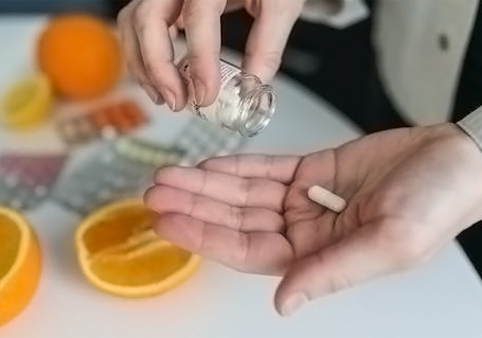Vitamins are
a necessity for humans
to maintain good health.
a necessity for humans
to maintain good health.
Vitamins are
a necessity for humans
to maintain good health.
a necessity for humans
to maintain good health.
Humans obtain vitamins through their diet since they are not synthesized in the human body. Ascorbic acid, or better known to us as vitamin C, is known as the “powerhouse vitamin”. Vitamin C is an antioxidant that helps to prevent long-term tissue damage. It also takes part in the production of collagen, a necessity for healthy skin, hair and teeth.


However, what vitamin C is most well-known for is its role in improving the immune system and in warding off diseases. Based on age and gender, the recommended daily consumption of vitamin C ranges from 75-120 mg. A large majority of vitamin C comes from citrus fruits such as oranges, limes, lemons and grapefruit, but the vitamin can also be found in various other fruits and vegetables.
In lieu of fruits and vegetables, individuals may take vitamin C supplements that provide the essential vitamin in synthetic form. Some vitamin C supplements provide an excess of vitamin C, between 10 and 20 times the recommended minimum dosage.
Determination of the vitamin C concentration in a solution is mostly done by a redox titration using iodine. As the iodine is added during the titration, the ascorbic acid is oxidised to dehydroascorbic acid, while the iodine is reduced to iodide ions.
Due to this reaction, the iodine formed is immediately reduced to iodide as long as there is any ascorbic acid present. Once all the ascorbic acid has been oxidised, the excess iodine is free to react with the starch indicator, forming the blue-black starch-iodine complex. This is the endpoint of the titration. The method is suitable for use with vitamin C tablets, fresh or packaged fruit juices and solid fruits and vegetables.
Sample Preparation
For vitamin C tablets: Dissolve a single tablet in 200 mL of distilled water (in a volumetric flask if possible).
For fresh fruit juice: Strain the juice through filter paper to remove seeds and pulp.
For packaged fruit juiceThis may also need to be strained through filter paper if it contains a lot of pulp or seeds.
For fruits and vegetables: Cut a 100 g sample into small pieces and grind in a mortar and pestle. Add 10 mL portions of distilled water several times while grinding the sample, each time decanting off the liquid extract into a 100 mL volumetric flask. Finally, strain the ground fruit/vegetable pulp through filter paper, rinsing the pulp with a few 10 mL portions of water and collecting all filtrate and washings in the volumetric flask. Make the extracted solution up to 100 mL with distilled water.
Alternatively the 100 g sample of fruit or vegetable may be blended in a food processor together with about 50 mL of distilled water. After blending, strain the pulp through filter paper, washing it with a few 10mL portions of distilled water, and make the extracted solution up to 100 mL in a volumetric flask.
For conducting titrations of ascorbic acid you will need HI931 Automatic Potentiometric Titrator.
HI931
Automatic Potentiometric Titrator
The HI931 Automatic Titrator is the answer to your dedicated titration needs. Fully customizable, the HI931 delivers accurate results and intuitive user experience, all in a compact package. Titrate for a variety of measurements at the push of a button including acids, bases, redox, and selective ions. No additional programming upgrades to purchase. The only things you need to start using the HI931 are a sensor and titrant.
- Small footprint so you can fully optimize your benchtop.
- Unmatched 40,000-step dosing pump for small volumes of titrant to help you achieve a very precise endpoint for greater consistency.
- Flexibility to store up to 100 methods.
For easier measurement of vitamin C in sample HANNA has another solutions.
Meet Photometric probes!
Meet Photometric probes!
HI900601 at 525nm
Photometric Electrode

HI900601 at 525 nm can be used to measure the concentration photometrically and it follows ISO 6557-2 standard. In this measurement, oxalic acid is added to extract the ascorbic acid. The solution is then titrated with DPIP and it changes from colorless to blue. Photometric probes detects the change of color at 525 nm.
Author:
Tajana Mokrović mag.nutr.
Tajana Mokrović mag.nutr.

With Great Product Come Great Results





